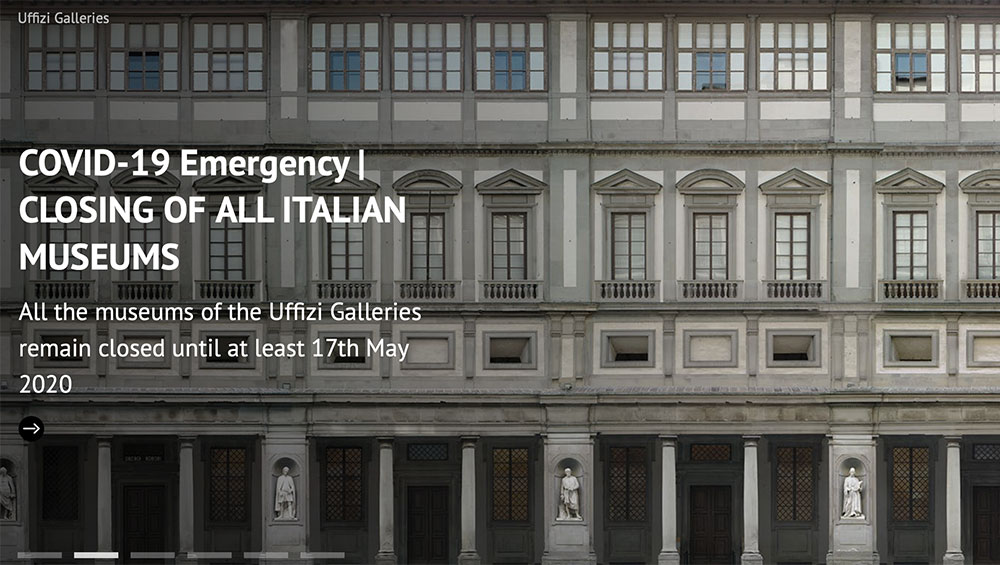
by ANGERIA RIGAMONTI di CUTÒ
Among Italy’s embarrassment of cultural riches is a niche yet exceptional body of work relating to the theme of pestilence. Giovanni Boccaccio’s storytelling extravaganza The Decameron (1353) is centred around the flight of 10 spirited, well-heeled friends from a plague-ridden Florence to a deserted country retreat – an exodus that would now elicit indignation – where they used stories as a means of self-protection (Boccaccio’s already ribald chronicles induced an even bawdier version in Pier Paolo Pasolini’s cinematic adaptation).
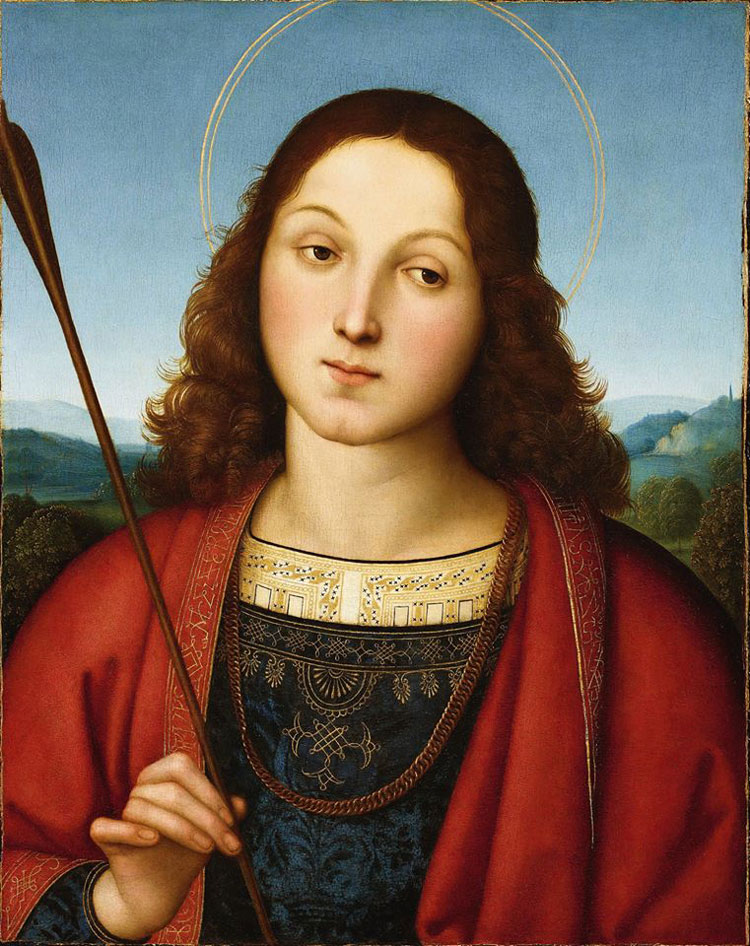
Raphael. St Sebastian, 1502-3. Oil on wood. Accademia Carrara, Bergamo.
Although advancing medieval Europe towards modernity, early humanists such as Boccaccio nonetheless still attributed the outbreak of the plague to rather nebulous causes, such as the influence of the planets, or God’s “just punishment for our sins”, a view shared by his contemporary, Francesco Petrarch, whose grief had driven him to write a series of classic sonnets for his beloved Laura, a victim of the Black Death. In an introduction addressed to his female readers, Boccaccio pleaded indulgence for reminding them of the devastation of the recent plague, arguing that: “This beginning, disagreeable as it is, is as a rugged and steep mountain placed before a delightful valley, which appears more beautiful and pleasant, as the way to it was more difficult: for as joy usually ends with sorrow, so again the end of sorrow is joy.”
By the 16th century, reason began to prevail. In the scientific realm, Sicily’s epidemic of 1575-6 was adroitly managed by the progressive physician Giovanni Filippo Ingrassia, known as the Sicilian Hippocrates. Ingrassia crafted innovative means of disease management, among which early detection and sophisticated quarantine protocols, including isolation hospitals. Crucially, he also considered the role of urban social conditions, such as housing and environmental pollution, in propagating disease, instigating public health measures and thus moving medicine into the realm of the empirical.
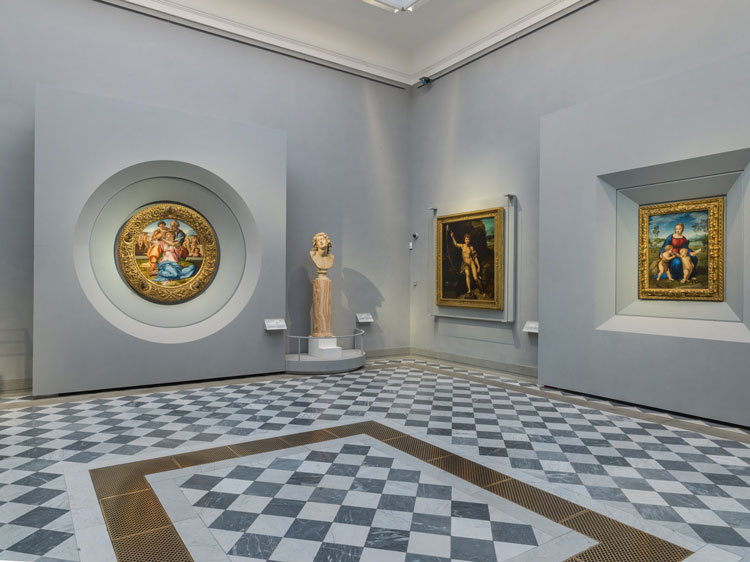
Michelangelo. Doni Tondo, 1505-6. Gallery view, Uffizi, Florence.
One of the most widely read classics of Italian literature, Alessandro Manzoni’s The Betrothed (1827-1840), devotes two chapters to the 1630 plague in northern Italy, an epidemic that felled around half of Milan, Verona and Venice. It sometimes makes for familiar reading, with its accounts of denial, scapegoating of foreigners, witches and unspecified “poisoners”, political ineptitude and overall paranoia. Manzoni was generally bleak about humanity’s reaction to plague, complaining that its brutalising effects “subdued every spark of human feeling or sympathy”, though he conceded the valiant altruism of Milan’s Archbishop Federico Borromeo.
The damage inflicted by self-seeking elites drove a more recent contribution to the Italian canon of pestilence, the magisterial Elio Petri’s film Todo Modo (1976), a dystopian portrait of a nation in crisis made during Italy’s gruesome – and not so distant – anni di piombo (years of lead). While Italy is beset by an undefined epidemic, a group of political heavyweights gathers in a claustrophobic, brutalist hermitage for a spiritual psychodrama convened by an uncharacteristically sinister Marcello Mastroianni. Power-addicted yet powerless and uninterested in stopping the plague, the rotten-to-the-core establishment, led by a magnetically unctuous Gian Maria Volonté, ultimately self-destruct in their hellish bunker, sonically accompanied by Ennio Morricone’s dissonant score. Unlike The Decameron or The Betrothed, Petri’s rendition of an epidemic allowed for no redemption, let alone light relief.
Back in the real world, then as now, cultural operators have to manoeuvre their institutions within complex economic, sociopolitical contexts, already fraught in Italy – and not only – before the Covid-19 emergency.
I asked the directors of three Italian museums about the initial consequences of the crisis, as well as potential repercussions on art institutions. Despite the obvious tribulations, all shared a belief in art’s power to heal.
Maria Cristina Rodeschini took over the direction of Accademia Carrara in Bergamo in 2017 following a thoughtful restoration programme that set off the museum’s fusion of exquisite private collections.
Overseeing the Uffizi, Palazzo Pitti and Boboli Gardens complex in Florence, Eike Schmidt was one of 20 “super directors” conscripted in 2015 to renew Italy’s museums, their uber-prestigious collections often hampered by a creaky, byzantine bureaucracy.
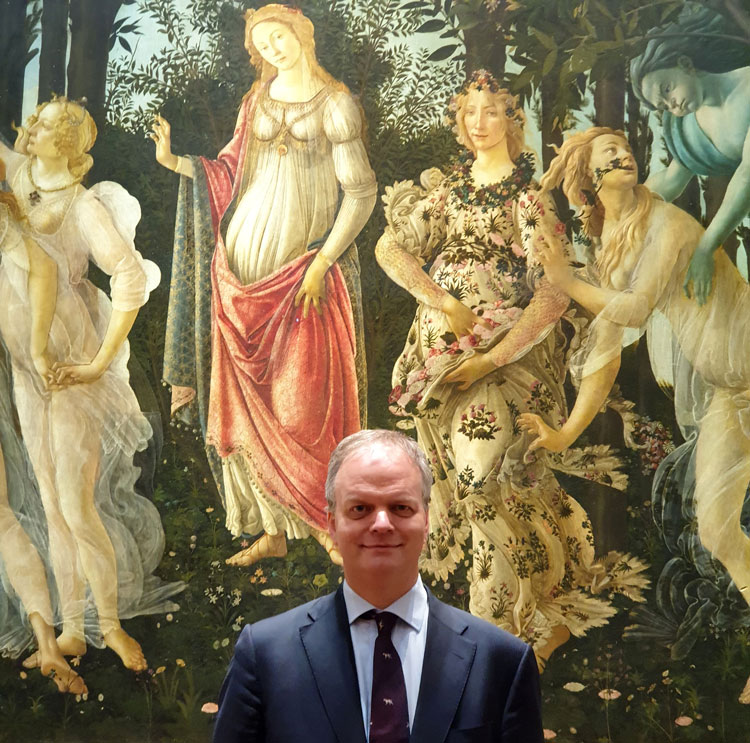
Eike Schmidt with Sandro Botticelli's Primavera, Uffizi, Florence.
Formerly part of the curatorial staff at the Solomon R Guggenheim Museum, in 2017 Karole PB Vail, granddaughter of Peggy Guggenheim, was appointed director of the Peggy Guggenheim Collection in Venice, one of the great collections of 20th-century modernist art.
Angeria Rigamonti di Cutò: What has been the immediate impact of the Covid-19 emergency, for example in terms of your staff or the fate of present and upcoming exhibitions? Are current shows being adapted for online viewing or has the crisis driven you to further develop online storytelling from the permanent collection?
Maria Cristina Rodeschini, Accademia Carrara: As everyone knows, the impact in Bergamo has been dramatic. People have been under lockdown since early March and have only been allowed some cautious movement since 4 May. Our technical staff have constituted a crucial stronghold, taking turns to monitor the galleries and storage rooms, and the wider staff have remained in contact by working remotely.
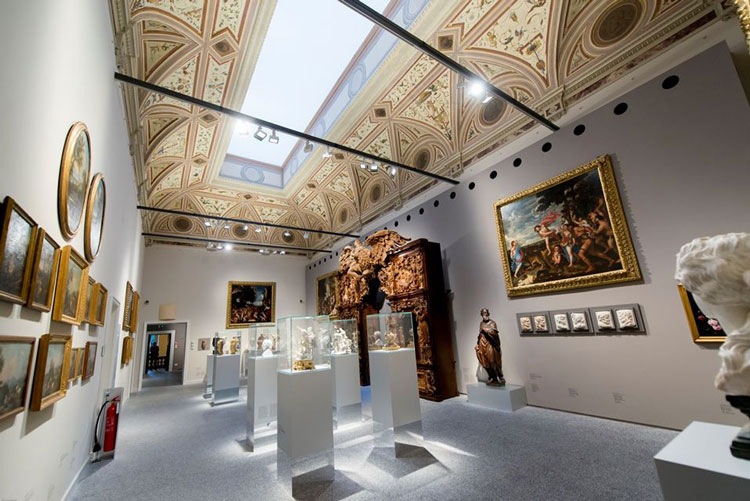
Accademia Carrara, Bergamo, gallery view.
The greatest sacrifice has been the exhibition dedicated to Simone Peterzano, pupil of Titian and maestro of Caravaggio. The show was seen for only three weeks and will close on 17 May. Along with the catalogue published by Skira, we shared its contents through our digital channels, and, via a photographic and video campaign, we’re producing a means of circulating knowledge of the exhibition and preserving its memory.
Eike Schmidt, Uffizi: Let’s start with one piece of good news: I can guarantee we will be able to keep all of our staff for the foreseeable future, even in the extreme case scenario of having to close partly or entirely until the end of the year. We have a larger than usual security and technical group on the premises 24/7 and, for the art historians, archaeologists, philosophers and philologists assisting on research and digitisation projects, this is an opportunity to collaborate with our scholarly staff and digital communications department.
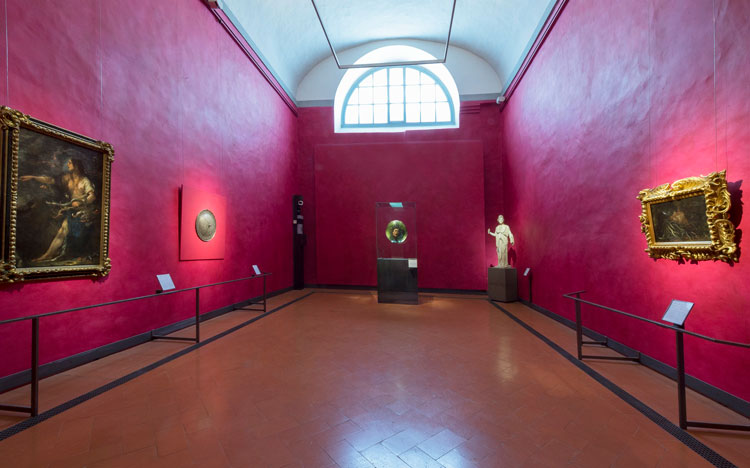
Caravaggio and 17th century gallery, Uffizi, Florence.
We stepped up digital communications on the very first day of lockdown, tripling our presence on our social media channels. We launched a campaign, #UffiziDecameron, named after Boccaccio’s tales; some people forget that seven of those storytellers were women and that gender composition closely resembles that of our digital strategies department.
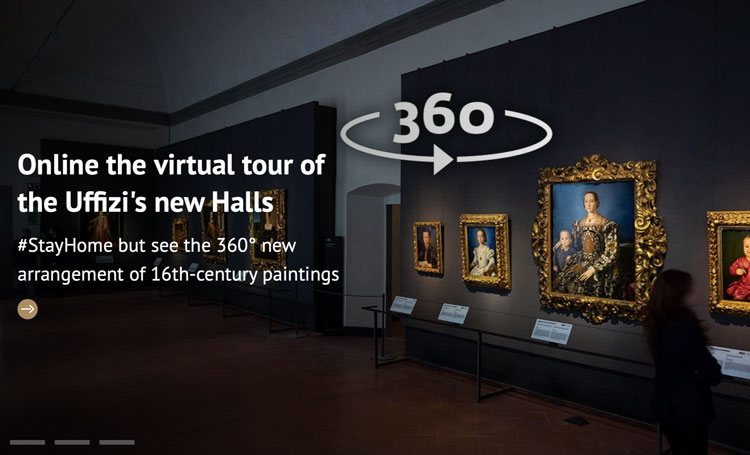
Uffizi website, 360 online tour. Screenshot captured 15 May 2020.
Karole Vail, Peggy Guggenheim Collection: Most of our staff are working from home (we have security guards 24 hours a day at the museum) and developing projects and activities on our new website and social media platforms. It is more important than ever to keep our museum audience engaged and close to us even while the museum is temporarily closed. Our audience may experience Migrating Objects: Arts of Africa, Oceania, and the Americas in the Peggy Guggenheim Collection, our current exhibition, thanks to in-depth presentations and videos by the curators and can also read excerpts from the catalogue on our new website.
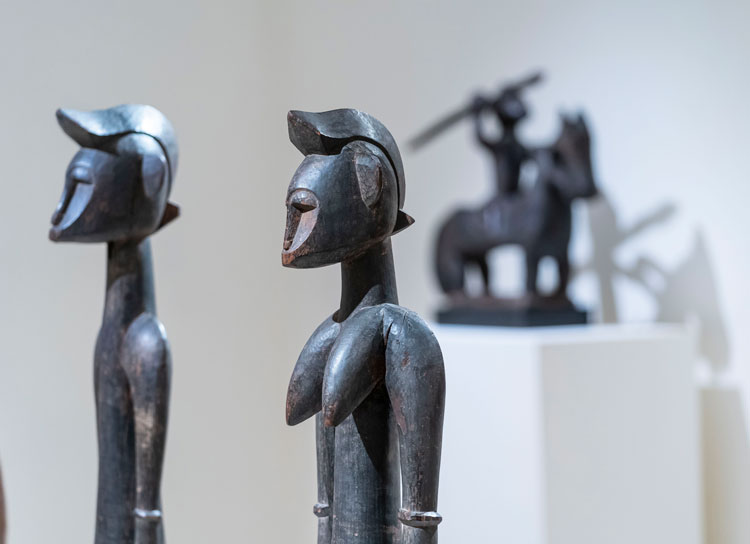
Migrating Objects: Arts of Africa, Oceania, and the Americas, installation view, Peggy Guggenheim Collection, 2020. Photo: Matteo De Fina © Peggy Guggenheim Collection, Venice.
ARC: And are initiatives such as the #iorestoacasa [#imstayinghome] social media campaign also valuable in maintaining a dialogue with a physically absent public during isolation?
MCR, Accademia Carrara: A dialogue with the public has been maintained via our digital channels. We had already implemented a digital strategy when the museum reopened in 2015, consisting of a website, social media channels and apps, a programme that in this situation has enabled us to step on the accelerator. If we hadn’t had that experience before the epidemic, it would have been impossible to put into place the subsequent proposals.
ES, Uffizi: Not only: I think we’re learning for the future that being more present and reactive on social media means we can open forms of new dialogue we hadn’t tested before, so there are advantages we want to keep in future. We have successfully experimented with dialogical forms on Instagram before and will add new channels to the mix over the next few weeks.
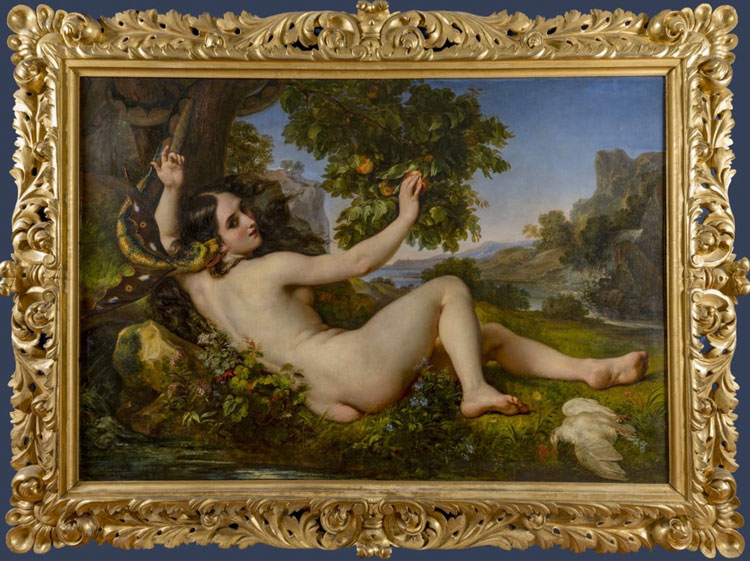
Giuseppe Bezzuoli (1789–1855). Eve tempted by the Serpent, Uffizi, Florence.
Our scholarly journal imagines has become even more important since scholars can’t go to the libraries any more. People are consulting it much more than before, and we have decided to publish it more frequently. So, we are communicating more to different audiences, from the very scholarly to an interested, educated mainstream.
For the website, we’ve further developed existing formats such as Fabbriche di Storie [Story Factories], storytelling audio tracks looking at intercultural interpretations of individual works, and HyperVisions, digital exhibitions with HD images that include a range of works from the collection [such as On Being Present: Recovering Blackness in the Uffizi Galleries].
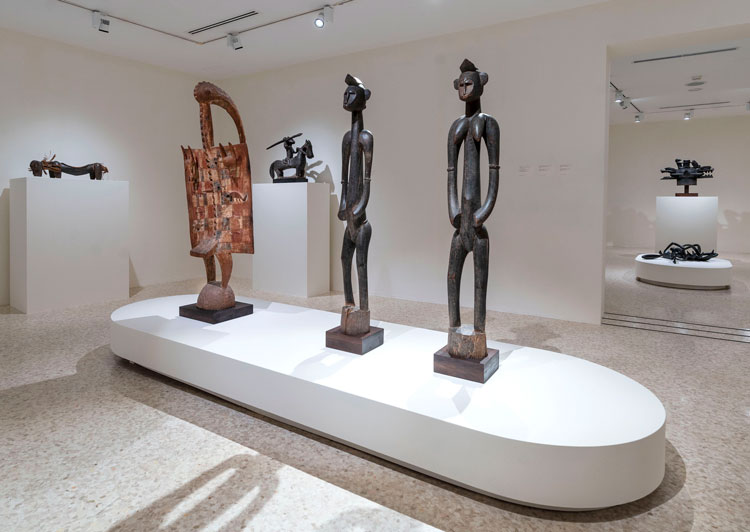
Migrating Objects: Arts of Africa, Oceania, and the Americas, installation view, Peggy Guggenheim Collection, 2020. Photo: Matteo De Fina © Peggy Guggenheim Collection, Venice.
KV, Peggy Guggenheim Collection: Our initiatives are absolutely essential in maintaining a dialogue and a sense of belonging to our institution. We have developed daily activities including anecdotes, talks and presentations on the collection and Peggy Guggenheim by staff members and interns, readings of excerpts from Peggy Guggenheim’s autobiography, videos with Migrating Objects curators, brief art talks and quizzes, as well as our historic Kids Day programme, which features educational activities and tutorials from the collection for our younger audiences and families.

Peggy Guggenheim Collection Comes to You. Website, screenshot captured 15 May 2020.
ARC: Do you think the Covid-19 crisis simply intensifies or accelerates directions Italian museums were already pursuing, such as enhanced digitalisation, accessibility to multifaceted audiences, community outreach and a move away from the museum-as-ivory-tower model? Or is this something quite different?
MCR, Accademia Carrara: The epidemic certainly accelerated the process, but anyone who hadn’t already grasped the crucial role of digital instruments in the contemporary age would be ineffective and find themselves paying the price for that delay. As far as the Accademia Carrara is concerned, we had to confront the problem of the very different situation we have had to negotiate, redesigning content to circulate given that direct contact with artworks is impossible with closed museums.

Accademia Carrara, Bergamo, gallery view. Photo: Gianfranco Rota.
ES, Uffizi: I think it accelerates those processes, but also adds to them as we’re in a different situation. At the Uffizi, we never considered those channels promotional tools to sell a physical museum visit, which we thought would be of little interest. We’ve always been centred around our diverse potential public and the experience of learning about art and many other fields of knowledge through art. So, this is more organic for us and we didn’t have to struggle with a complete change in communication strategy as might be the case with institutions which mainly use these channels to communicate a particular exhibition or event, or a discount.
Another advantage is that we intend to open further programming to communicate with Italians – who are at home all week – in Italian, so we now publish our social media posts earlier in the day and many people look at these first thing in the morning.
KV, Peggy Guggenheim Collection: The prevalence of digital media in our lives is inevitable, but also necessary for our museum and we are certainly moving in this direction more and more, with the intent of reaching as wide an audience as possible. We are more active than ever with programmes and activities that involve the local community, schools and beyond. We believe that our museum is open to all, a space of freedom that gives the opportunity to view art in an exceptional setting that we want to share. In her day, Peggy Guggenheim opened the doors of her house museum to the public in the belief that it was her duty to share her collection. Our institution is certainly not an ivory tower.
ARC: When you do reopen, what safety measures do you envisage adopting? There have been suggestions of implementing restrictions, such as maintaining distance between visitors, limiting numbers, timed entries and so on. Applying and timing such measures must be a daunting prospect: in Hong Kong museums had to close for a second time after reopening following a temporary wane in contagion.
MCR, Accademia Carrara: From 18 May Italian museums will be able to reopen, so we are adopting the necessary measures to ensure the safety of our staff and visitors. These include maintaining a distance of one and a half metres between visitors, thus reducing the number of people in individual galleries. The timing of access and visits will be radically different from before and overall visitor numbers will contract as a result. There are two possible remedies: extending opening hours, though this would have an impact on costs that Carrara could not sustain; another solution would be to implement a booking system to enhance access and reduce waiting times as much as possible.
ES, Uffizi: It was the same in Lombardy. There are some obvious measures: social distancing will have to stay in place for quite a while, even after a vaccine is available – it is likely these will continue through the first half of 2021. We will live through some intermediate phases for at least a year, I would expect, and some elements might remain beyond that. When we do reopen, it won’t be to the status quo ante. The additional safety measures will be announced once the government has made the decision and we are studying the details with several ministries in Rome, as well as looking at what people are doing in other countries. Any safety measures required in public spaces, such as wearing masks, will, of course, apply in the museum and there will be regular sanitisations.
KV, Peggy Guggenheim Collection: We hope to open as soon as possible, and when it is safe to do so as ordered by national decree. We must ensure that our visitors and our staff are safe and healthy at all times, by maintaining the rightful distances between people, limiting numbers and so on. A similar thing happened to us, but earlier on. We had to first close on 24 February, then we reopened for a few days, and then the lockdown was upon us. When we do reopen, it will be a slow opening and we do not expect many visitors. The first will be Venetians, we hope, then will come Italians, Europeans, and slowly those from the US, Asia, Australia and beyond.
ARC: At a less pragmatic level, do you think the current crisis and subsequent measures will undermine the visceral enjoyment of seeing artworks in the flesh in the longer term?
MCR, Accademia Carrara: On the contrary, I think that the crisis has increased the desire of art lovers and the wider public to enjoy our magnificent collections in person. The distinctive feature of the museum is direct contact with the artwork, so all the useful digital strategies at our disposal won’t be able to supplant that fundamental and thrilling experience. We’ll have to get accustomed to an adjustment in the way we access museums and conceive new tools available to the public during their visit.
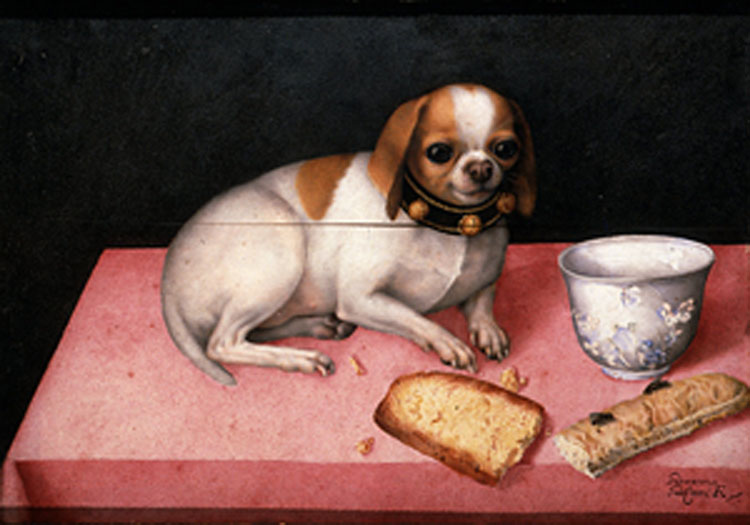
Giovanna Garzoni, Dog with biscuits and a Chinese cup, c1640. Pitti Palace, Florence.
ES, Uffizi: On the contrary. We see now that people crave the physical presence of the artwork, but I think it will help differentiate the digital and physical spheres in an ultimately better and more productive way. There’s no reason to believe that the digital will in some way take over and replace the physical museum experience. The absence of the possibility of going to see great works of art in the museum, even after only a little more than a month, has shown the emergence of the desire to reconnect with art so I’m not at all worried about that. It will, however, take quite a while before the international boundaries will open, so there will be a time when we won’t have any international visitors.
KV, Peggy Guggenheim Collection: I think that there is nothing like the experience and enjoyment of seeing the artwork in the flesh. That is quite irreplaceable. At the same time, I think we have to develop our digital platforms all the more powerfully, as they have become such an integral part of our everyday lives, and touch all kinds of communities of all ages, especially the younger generations whom we eventually need to bring to the museum. And we also have to do so for the benefit of those who are not able to visit us at the museum in person. We have to serve visitors who come to the museum, and we also need to serve those who follow us virtually.

Raphael. St Sebastian, 1502-3. Oil on wood. Accademia Carrara, Bergamo.
ARC: Almost inevitably, our psychological wellbeing will also be a victim of the pandemic. In this respect, presumably museums can play a valuable curative role in the longer term for this collective anxiety, functioning as a refuge and as an intellectual and emotional tonic?
MCR, Accademia Carrara: The museum is a site of collective memory, in which visitors need to recognise themselves, feel at home, have fun, feel good and nourish the desire to return. Empathy with the public is a central theme. Following this crisis, the capacity to soothe, to elicit interest and to “heal” gives the museum new strings to its bow. Some of our educational projects are already exploring this potential, for example, with regard to people with Alzheimer’s disease. The Accademia Carrara’s intervention in a first-rate care home, before the current crisis, yielded surprising results. The medical staff and patients claim that the presence of the images of our paintings on the walls of the clinic, significantly enlarged and studied in their context and in detail, provided relief, comfort and joy.
ES, Uffizi: Indeed, and I think that’s a very important point that I already see on the internet and social media. I would expect and I hope that in the future “new normal” this role will continue. I think this will raise additional awareness of the role of the museum, a new role with which they have been struggling in the past few years which needs to add to the function of study and conservation. Works of art also have a high emotional potential and a role in the self-identification of people, for each of us in different ways. So, I think art and museums will emerge stronger after the emergency.
KV, Peggy Guggenheim Collection: Art has extraordinary transformative and healing powers. Artists have always believed this, and it is our duty as a museum to offer that experience, to offer something beautiful, special and memorable, to educate, challenge, inspire, and to ensure that our visitors leave the museum with a refreshed and enhanced mind and spirit, and that they will always want to return.
Titian and Caravaggio in Peterzano, Accademia Carrara, Bergamo, until 17 May 2020.
The Greatness of the Universe’ in the Art of Giovanna Garzoni, Pitti Palace, Florence, until 24 May 2020.
Giuseppe Bezzuoli (1789-1855): A Master Painter of the Romantic Era, Uffizi Galleries, Florence, until 31 July 2020.
Migrating Objects: Arts of Africa, Oceania, and the Americas in the Peggy Guggenheim Collection, Peggy Guggenheim Collection, Venice, until 14 June 2020.